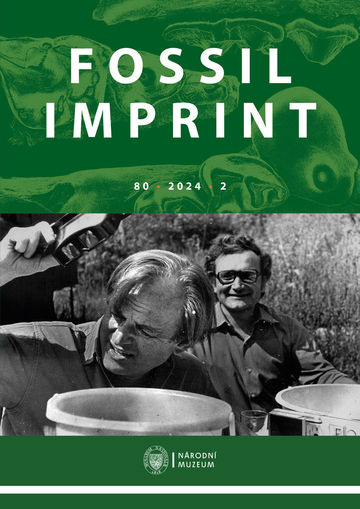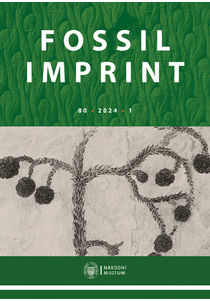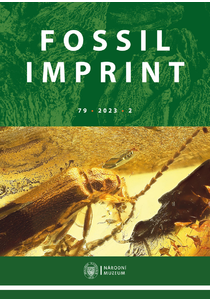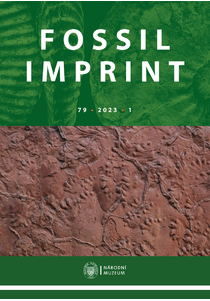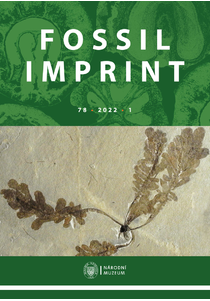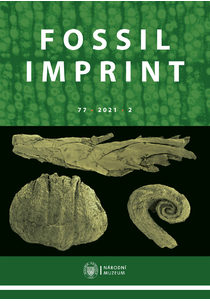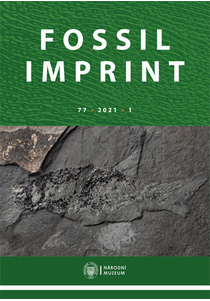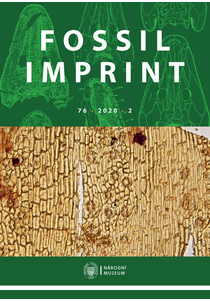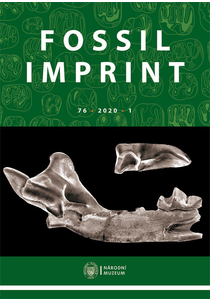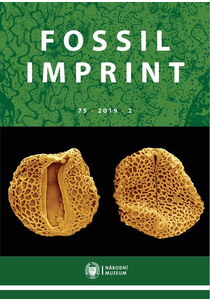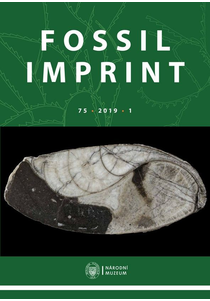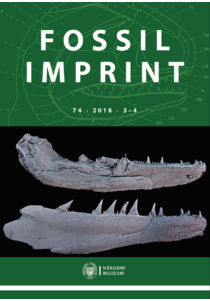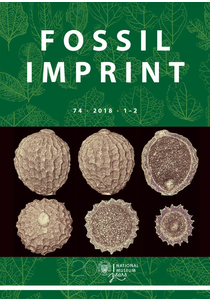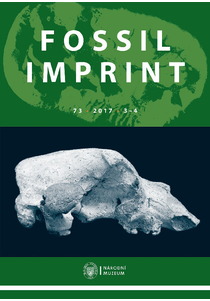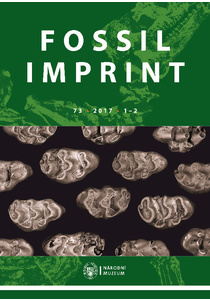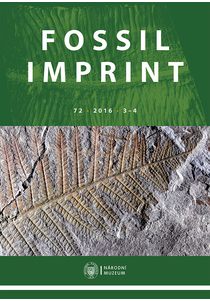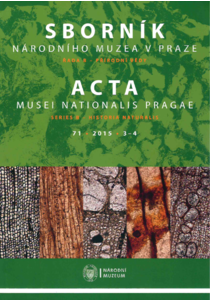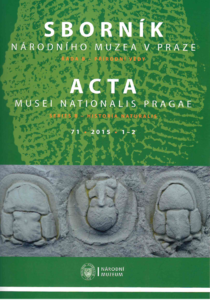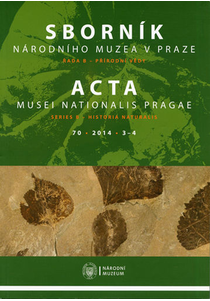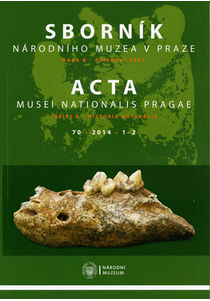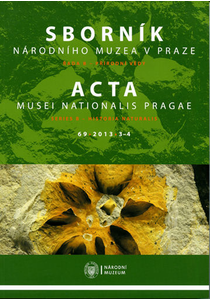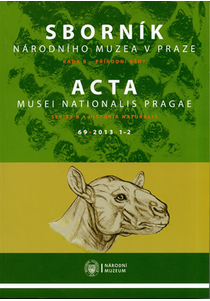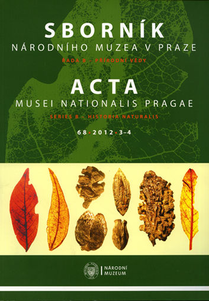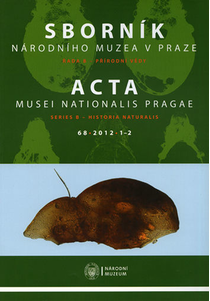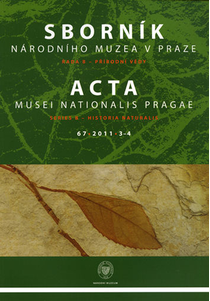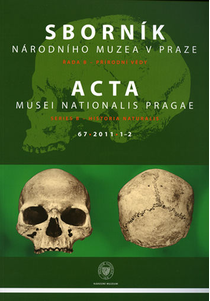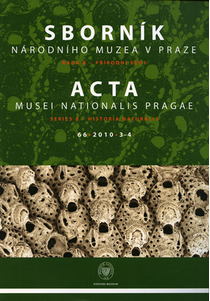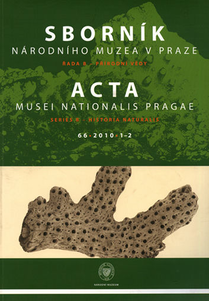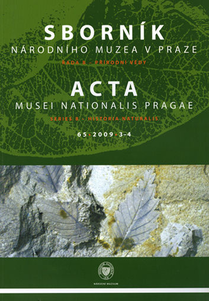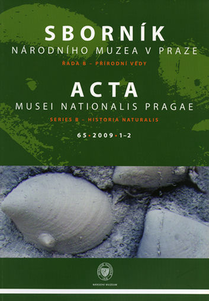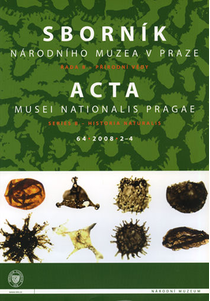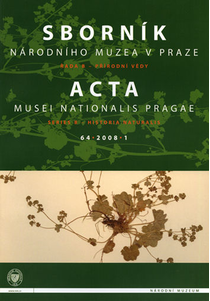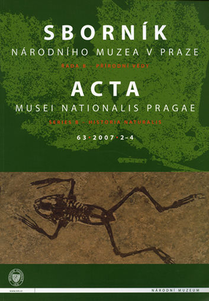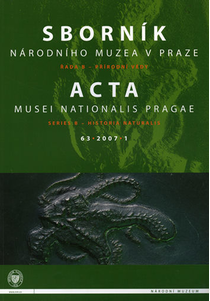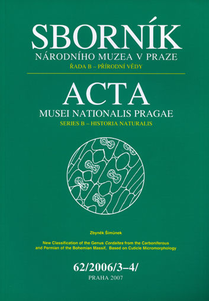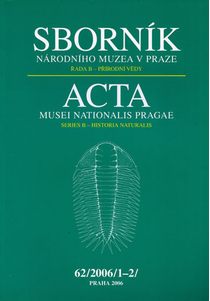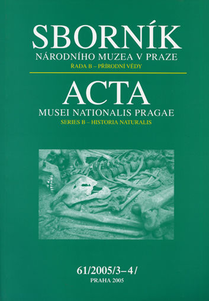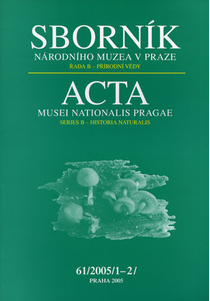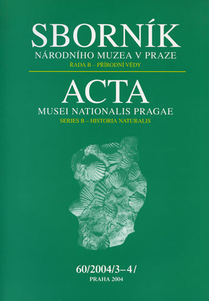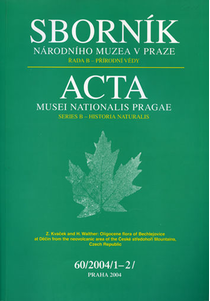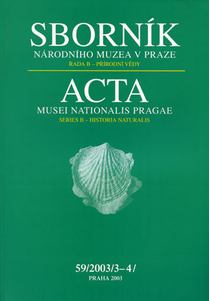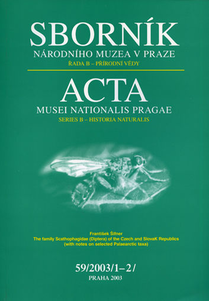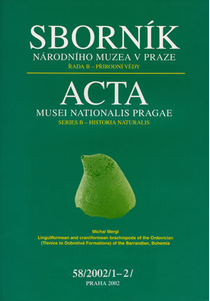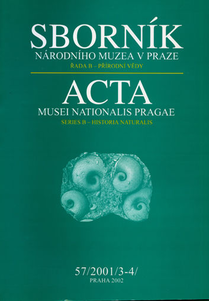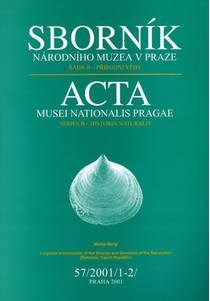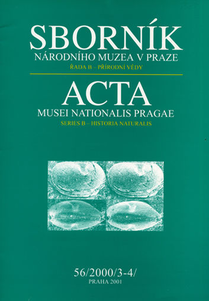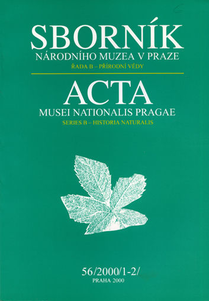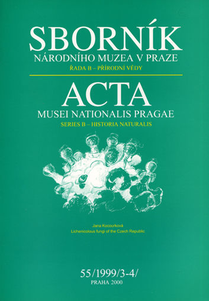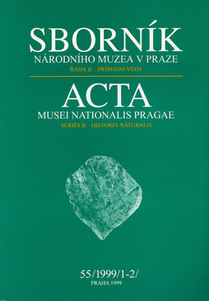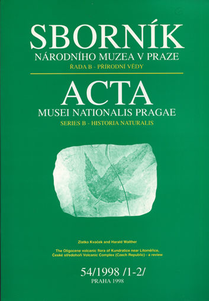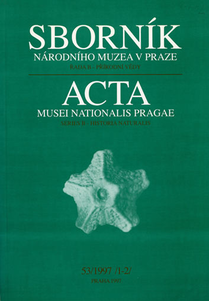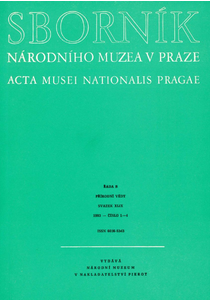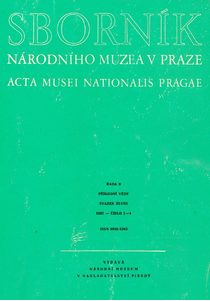Fossil Imprint (formerly Acta Musei Nationalis Pragae, Series B – Historia Naturalis) publishes original scientific papers and reviews from paleontology, palaeoanthropology, biostratigraphy, palynology, archaeobotany, archaeozoology and related geological and biological disciplines, such as quaternary geology concerned with reconstruction of paleoclimate or paleoenvironment. There are no pre-set limits on page count or number of illustrations, but all content must be pertinent to the theme of the submission.
Potential guest editors who are interested in publishing a monothematic issue or conference proceeding that fits in with the subject matter of the journal are kindly requested to contact Editor-in-Chief Jiří Kvaček (e-mail: jiri_kvacek@nm.cz).
Fossil Imprint is an international scientific journal, published since 1938 by the Natural History Museum (National Museum, Prague, the Czech Republic). Originally, it was intended for publishing essays and monographs from all natural science disciplines and bears the bilingual title Sborník Národního muzea v Praze, řada B – Přírodní vědy/Acta Musei Nationalis Pragae, Series B – Historia Naturalis. Beginning in 2016, there is a sharper focus on palaeontology and related disciplines, reflecting the change of title to Fossil Imprint.
Contact
Editor-in-Chief:
RNDr. Jiří Kvaček, CSc., National Museum, Prague
jiri_kvacek@nm.cz
Executive Editor:
Zuzana Heřmanová, Ph.D., National Museum, Prague
fossil.imprint@nm.cz
Department of Palaeontology
National Museum, Prague
Cirkusová 1740
193 00 Praha 9
Czech Republic
Novelty of research material and authorship
The authors of the manuscripts are responsible for the scientific content and novelty of the research materials. Articles submitted for publication should not have been previously published. Authors may not submit a typescript that is under consideration elsewhere. Plagiarism and falsification of research data are considered as misconducts. All sources of formerly published data must be properly cited in the text and in the list of cited literature. Authors are responsible for ensuring that all persons cited in the text as pers. com. are aware of and consent to such a citation. All authors should be listed on submitted papers.
Research funding
The source of research funding should be listed on all papers in separate paragraph.
Copyright
All copyright permissions must be cleared and if necessary, paid for by the author. It is also the author’s responsibility to include whatever acknowledgements are stipulated by institutions holding the copyright. If necessary, evidence in writing that such permissions have been secured from the rights-holder must be made available to the editors. Plagiarism and falsification of research data are considered unethical behavior.
Review
All manuscripts submitted to the National Museum journals are peer-reviewed by least two independent reviewers. Names of reviewers are kept confidential by the journal’s editors.
Editor-in-Chief:
Ass. Prof. Jiří Kvaček, CSc., National Museum, Prague
Executive editors:
Zuzana Heřmanová, Ph.D., National Museum, Prague
Jan Sklenář, Ph.D., National Museum, Prague
Jan Wagner, Ph.D., National Museum, Prague
Co-editors:
Prof. Per Ahlberg, PhD, Uppsala University, Uppsala
RNDr. Petr Budil. Ph.D., Czech Geological Survey, Prague
Christopher J. Cleal, PhD, National Museum Wales, Cardiff
RNDr. Jiřina Dašková, Ph.D., National Museum, Prague
Prof. Dr. Johanna Eder-Kovar, Stuttgart State Museum of Natural History, Stuttgart
Ass. Prof. Jorge Esteve, PhD, Universidad de los Andes, Bogotá
Prof. Oldřich Fejfar, CSc., National Museum and Charles University, Prague
Prof. Rodney M. Feldmann, PhD, Kent State University, Kent
Dr. Lilla Hably, PhD, Hungarian Natural History Museum, Budapest
Prof. Ivan Horáček, CSc., Charles University, Prague
Ass. Prof. Martin Ivanov, Dr., Masaryk University, Brno
Ass. Prof. Martin Košťák, Ph.D., Charles University, Prague
Prof. Zlatko Kvaček, DrSc., Charles University, Prague
Prof. Steven R. Manchester, Ph.D., Florida Museum of Natural History, Gainesville
Prof. Jorge Morales, Museo Nacional de Ciencias Natural, Madrid
Prof. Ronald L. Parsley, PhD, Tulane Univerzity, New Orleans
Ass. Prof. Petr Pokorný, Ph.D., Charles University, Prague
Prof. Stanislav Opluštil, Ph.D., Charles University, Prague
Ass. Prof. Martin Sabol, PhD., Comenius University, Bratislava
Paul D. Taylor, PhD, Natural History Museum, London
Dr. Torsten Utescher, Senckenberg Research Institute, Franktfurt am Main
RNDr. Petr Velemínský, Ph.D., National Museum, Prague
Associate editors:
Dr. Gennady F. Baryshnikov, Dr.Sci., Zoological Institute RAS, Saint-Petersburg
RNDr. Jiří Bek, DSc., Geological Institute of the CAS, v. v. i., Prague
Dr. Alexei B. Herman, Geological Institute RAS, Moscow
Dr. Hannes Löser, Universidad Nacional Autónoma de México, Hermosillo
Prof. Michal Mergl, CSc., University of West Bohemia, Plzeň
RNDr. Radek Mikuláš, DSc., Geological Institute of the CAS, v. v. i., Prague
Dr. Imran Rahman, Oxford University Museum of Natural History, Oxford
Dr. habil. Mihai E. Popa, University of Bucharest, Bucharest
RNDr. Ladislav Slavík, CSc., Geological Institute of the CAS, v. v. i., Prague
Ass. Prof. Selena Smith, Ph.D., University of Michigan, Ann Arbor
RNDr. Vojtěch Turek, CSc., National Museum, Prague
Sébastien Villotte, PhD, Université de Bordeaux, Bordeaux
Fossil Imprint (formerly Acta Musei Nationalis Pragae, Series B – Historia Naturalis), publishes original scientific articles from a variety of disciplines, and monographs, unpublished elsewhere.
Author guidelines can be downloaded in a pdf file here.
General requirements
Articles are accepted only in English; only in rare circumstances will the editors make an exception. Manuscripts must be in DOC or RTF format, sent via email to the Editorial Office (fossil.imprint@nm.cz).
Text must be left-justified, one-and-half-spaced, single standard font (like Times New Roman, Courier New, etc.), 12 point, without breaking hyphens and no images in the text. Name(s) of author(s) of scientific name(s) in small capitals, with comma inserts between the name and year. Italics are only for scientific genus-group and species-group names.
Submission structure
Title page must contain (1) the article’s title, (2) full name and address of author(s), (3) bibliographic identification formatted as follows: Novák, J. et Jones, K. L. (1995): Article title (see 1). – Fossil Imprint, 50(1-2): 12–95, Praha. ISSN 2533-4050 (print), ISSN 2533-4069 (on-line)., (4) English abstract (max. 200 words), (5) keywords (English, max. 10 words). Following the article text (6) come acknowledgements (7), cited literature (8), tables with explanations (9), explanations of images embedded in text (10) and explanations of plates (11).
Citations
For inline citations, use standard font, without dashes between author and year. If there are two authors, they are separated by “and”; if there are more than two authors, “et al.” is used, again in standard font [e.g. (Heissig and Fejfar 2013) or (Rabeder et al. 2010)]. If multiple citations occur in a row, they are arranged chronologically from oldest to newest, separated by commas (e.g. Rode 1935, Musil 1959, 1965a, b, 1991, Rabeder 1989). All publications cited in the text must be included in the list of cited literature, ordered alphabetically by author and year of publication (see examples). Cited publications in Czech or other non-congressional languages will be cited in the original, with an English translation in square brackets and original language name in parentheses [e.g. (in Czech) or (in Slovak with German summary) etc., see example (B) below]. When transcribing Cyrillic, the author must use this transliteration table.
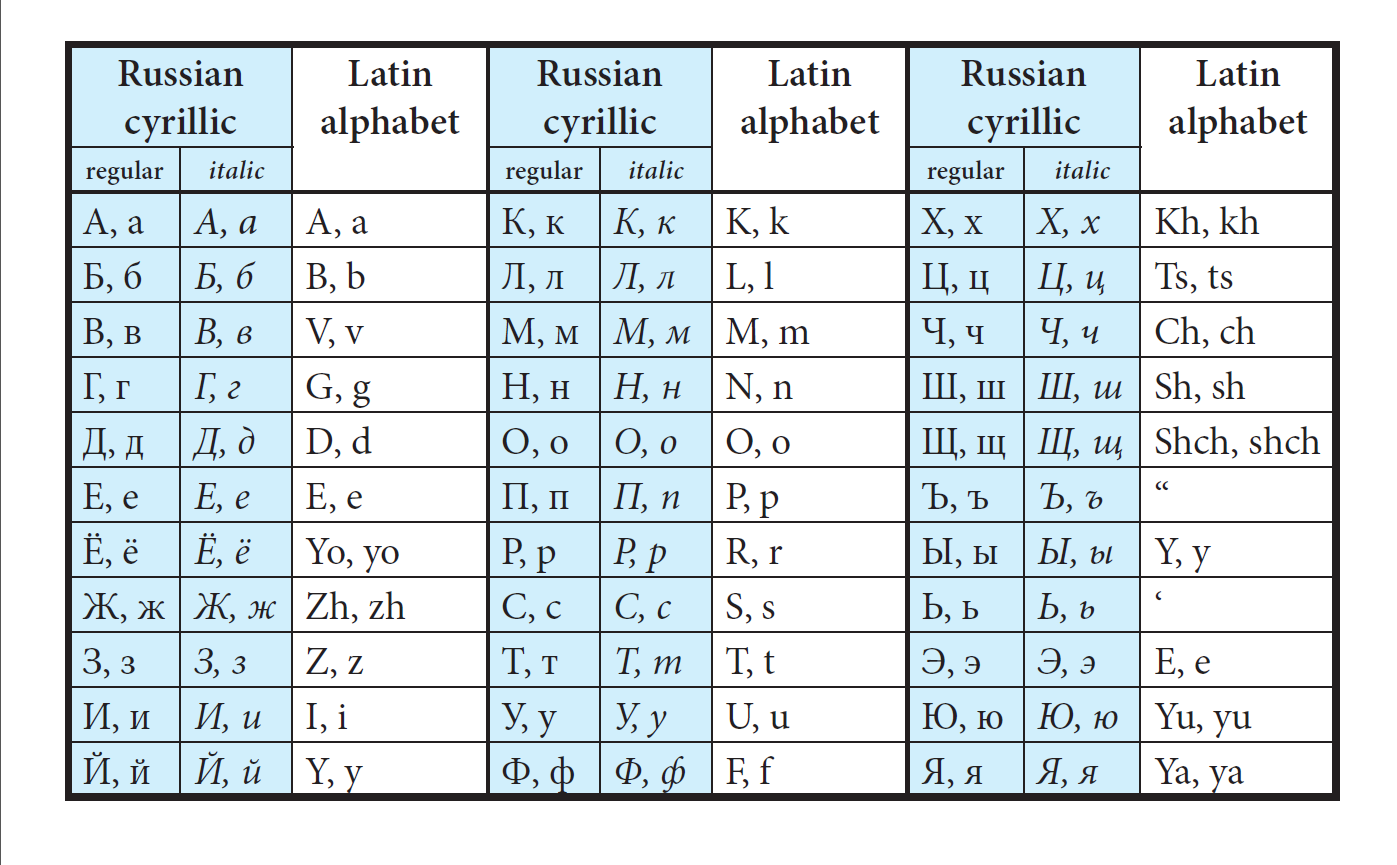
Journal titles are given in unshortened form. If Internet sources (other than electronic journals) are cited, cite them in the text and not in References.
Example of citation ordering
Arthur, A. (2015a)
Arthur, A. (2015b)
Arthur, A. (2016)
Arthur, A., Conan, C. (2011)
Arthur, A., Conan, C., Doyle, D. (2010)
Arthur, A., Doyle, D. (2008)
Example citations
Journals
(A) Drinnan, A. N., Crane, P. R., Friis, E. M., Pedersen, K. R. (1990): Lauraceous flowers from the Mid-Cretaceous of eastern North America. – Botanical Gazette, 151(2): 370–384.
(B) Shpinyov, E. S. (2014): Novye dannye ob evripteridakh (Eurypterida, Chelicerata) verkhnego karbona Donetskogo ugol’nogo basseyna [New data on eurypterids (Eurypterida, Chelicerata) of the Upper Carboniferous of the Donets Basin]. – Paleontologitcheskiy Zhurnal, 2014(3): 67–72. (in Russian)
Proceedings and monographic series
(C) Mutvei, H., Dunca, E. (2007): Connecting Ring Ultrastructure in the Jurassic Ammonoid Quenstedtoceras with Discussion on Mode of Life of Ammonoids. – In: Landman, N. H., Daivs, R. A., Mapes, R. H. (eds), Cephalopods Present and Past: New Insights and Fresh Perspectives. Springer, Dordrecht, pp. 239–256.
(D) Pohar, V. (2011): History of Research in the Ajdovska jama near Krško (Slovenia). – In: Pacher, M., Pohar, V., Rabeder, G. (eds), Ajdovska jama. Palaeontology, Zoology and Archaeology of Ajdovska jama near Krško in Slovenia. Mitteilungen der Kommission für Quartärforschung der Österreichischen Akademie der Wissenschaften, 20: 5–10.
(E) Gale, A. (2011): The Phylogeny of Post-Palaeozoic Asteroidea (Echinodermata, Neoasteroidea). – Special Papers in Palaeontology, 85: 1–112.
If the title of the proceedings is not clearly determinative, the publishing authority is cited as well:
(F) Barlow, A. E. (1899): Report on the area included by the Nipissing and Temiscaming map-sheets. – Annual Report, N.S., Geological Survey of Canada, 10(1897): 5–301 (report I).
(G) White, J. M. (2014): The palynostratigraphy, age, and environment of strata penetrated by the Mallik 5L-38 gas-hydrate research well, Northwest Territories, determined by differentiating the recycled and contemporaneous palynomorphs. – Bulletin, Geological Survey of Canada, 604: 1–85.
Abstracts
(H) Santi, G. (2014): Cave Bears in Italy: Updates and New Perspectives. – In: Rabeder, G., Kavcik, N. (eds), Abstracts and Excursion-guide, 20th International Cave Bear Symposium, September 10th – 13th 2014, Corvara, Italy, p. 5.
Books
(I) Velenovský, J. (1885): Die Gymnospermen der böhmischen Kreideformation. – Ed. Grégr, Prag, 34 pp.
Manuscripts
(in parentheses after the citation is the name of the library in which the manuscript is stored)
(J) Macák, F. (1966): Křídový útvar v sz. Čechách (svrchní turon až santon) [Cretaceous formation in NW Bohemia (Late Turonian to Santonian)]; Kandidátská práce [CSc. thesis]. – MS, Česká geologická služba, Prague, the Czech Republic, 82 pp. (in Czech) (copy in library of Czech Geological Survey)
References to figures
Images that are embedded in the text are marked: “Text-fig. 1a”, and photographs embedded in the text are marked: “Pl.1, Figs 1b–3a”. When referring to an illustration in another article, abbreviations are in lower case in front (e.g.: Ettingshausen 1866: pl. 13, fig. 13). Approximate position of embedded images is indicated in the text using upper case in square brackets (e.g.: [TEXT-FIG. 1]).
Illustrations
Images and diagrams must match the column width (84 mm) or printed page size (174 × 238 mm). Size and type of symbols are chosen by the author so that they are legible, and will remain so even after anticipated size reduction (ideal is the image prepared in full size and primary font in 16 points). The author must be careful to maintain a single font for each level of captions and unified graphic symbols (see templates and examples here).
Text-Fig_EXAMPLE-01.png
TemplateCDR_v9_FIN.cdr
TemplateCDR_X5_FIN.cdr
The font for illustrations should be without serifs (Arial is best), regular or bold. Parts of images embedded in the text (Text-fig.) should be identified with lower case Latin letters; in plates, Arabian numerals. For marking details or different views of the same object, lower case Latin letters are used (1a, 1b…). An example is here:
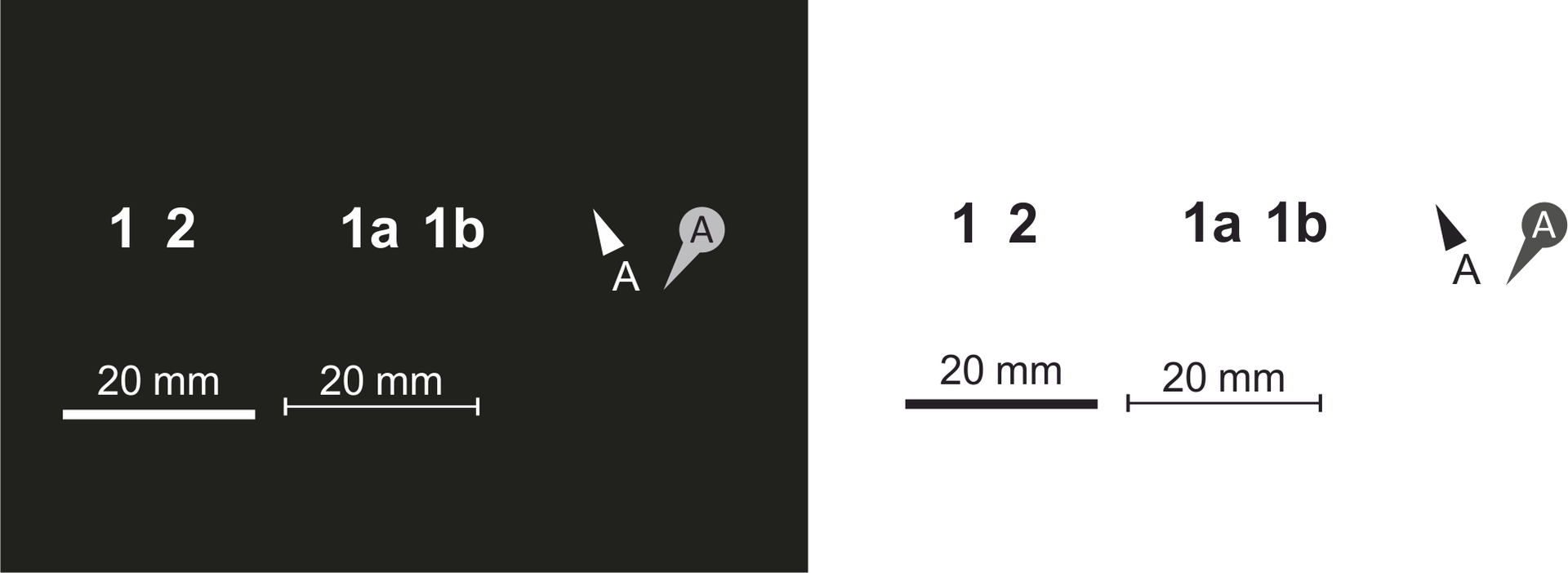
Vector graphics and manual illustrations
Such images are accepted only in electronic form in PNG or TIFF format. Resolution of these images must be at least 600 dpi, and width is 84 mm for column or 174 mm for page. Besides exports in the above-mentioned formats, we also request that authors provide originals in CDR or AI, if they are available. Graphs are accepted in XLS format (including source data), or as TIFF, EPS or PNG images; tables as separate files in DOC or XLS (e.g. “tab1.doc”, “tab2.xls”…).
Photographs or plates
Photographs in electronic form are preferred. They should meet the following criteria: black-and-white (i.e. grayscale) or color (CMYK), minimum resolution 300 dpi, in the final print size or slightly larger, with proper tonal balance (without excessive highlighted areas). Dimensions of all photographs must be specified by the author. When assembling plates, the author should avoid creating large blank areas, and sort the photographs from left to right, and from top to bottom. Actual size of object is indicated by the use of a scale-bar in the plate. It is also possible to cite the magnification in the comments (e.g. “25×”). An example of an ideally laid out plate is the following:
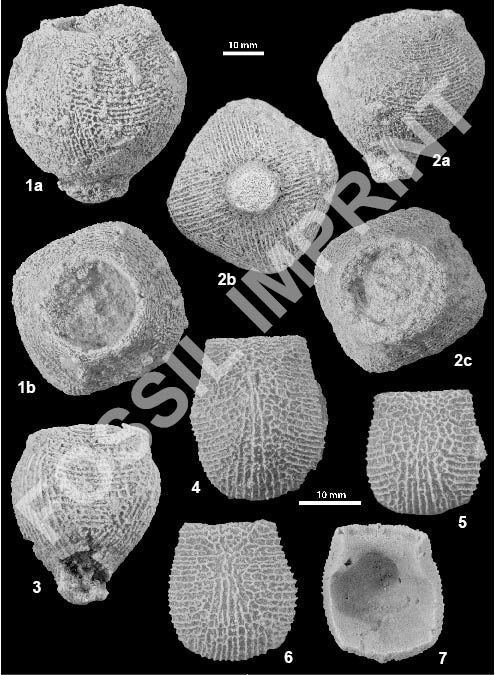
Manuscripts fulfilling all above specified conditions will be submitted to at least two independent reviewers, and the editor will make the final publication decision. All accepted texts will be subject to a language review. The author will receive 20 copies of his printed article, and may request an electronic version (PDF) as well.
Submit your manuscripts to the Editorial Office: fossil.imprint@nm.cz.

